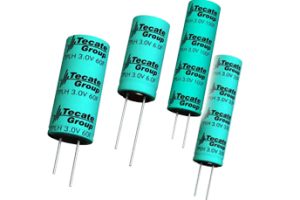Knowles has introduced two series of triple cell PCB-mount supercapacitor modules, based on Cornell Dubilier’s DGH and DSF series, which it now owns. DGH types work up to 8.1V (-40 to +65°C) and measure between 25 x 8.5 x 16mm high for the 330mF version, to 39 x 13 x 33mm for the 5F. They will also work up to ...
Tag Archives: supercapacitor
Energy harvester dc-dc can run from two ambient sources
E-peas has created a power IC that can mediate between two energy harvesters, a 5V charger, a power store and a load. AEM13920 can work from any combination of two sources including: photo-voltaic cells, thermo-electric generators, RF energy harvesters or kinetic pulsed sources. “For instance, a remote control could have separate PV cells on its front and rear, to maintain ...
Supercapacitor banks for energy storage
Kyocera AVX has announced a range of high-capacity supercapcitor banks with low leakage. “SCM Series supercapacitor modules are rated for operating temperatures from -40°C to +65°C and lifetimes that extend to millions of cycles,” according to the company. “They are also lead-free compatible, RoHS compliant, and compliant with the UL 810A standard for electrochemical capacitors.” Initially there are five versions: ...
18V supercaps delivers up to 47.6kW
Eaton has introduced a pair of 500F sealed supercapacitor banks, replacing its earlier XLR-16R2507-R, according to component distributor Rutronik, which is stocking the new parts. They are: The 16.2V XLR16R2507B-R, which can store up to 18.2Wh and deliver up to 38.6kW or 2.19kA peak (9.6kA shorted, 121A continuous). Maximum ESR is 1.7mΩ and 5.2mA leakage is expected. The 18V XLR-18R0507B-R ...
Micro-supercapacitors can be built into ICs
Researchers at the Dalian Institute of Chemical Physics have found a way to deposit micro-supercapacitors consistently on surfaces such as silicon as a way to add energy storage directly to ICs. This is not the first time that supercapacitors have been deposited on such substrates, but the team claims to have combined unpresidented cell density, electrochemical performance and cell-to-cell consistency ...
‘Paper’ supercaps reach 10F
Researchers at Sweden’s Digital Cellulose Center have improved their paper supercapacitor technology, getting 10F from a demonstration device. The active ingredient of the capacitor is a water-based ink made from the conductive polymer PEDOT:PSS and cellulose pulp derived from softwood, plus some other ingredients including activated carbon. Previously, the Center screen-printed this onto an aluminium-coated plastic substrate, but in this ...
Quad balancer IC for 3.0V supercaps
Advanced Linear Devices has introduced an IC that will balance four supercapacitors connected in series – to help prevent any of them being damaged by over-volting as they charge. Like other balance ICs in the company’s range, it does not use op-amps and a voltage reference. Instead it has four precision-trimmed mosfets that act as shunt regulators when connected gate-to-drain. ...
Pouch-style supercapacitors reinforce batteries
Kyocera AVX has introduced a series of pouch-style supercapacitors for decreasing current surges in batteries. Called the SCP Series and branded PrizmaCap, they “can be used on their own as system power backup devices, replacing batteries in some cases, or they can be used in conjunction with primary or secondary batteries”, according to distributor Anglia, which is stocking the parts. ...
3V supercapacitors work up to 65°C and deliver amps
Tecate has added 3V supercapacitors to its TPLH series of otherwise 2.7V parts, designed for long life and high-temperature high-humidity use. “The new series provides the pathway to higher voltage and greater energy density within the same industry-standard cell footprints,” according to distributor Omni Pro, which is stocking the parts. “Technology improvements are a direct result of propriety innovation in ...
Flexible stretchy supercapacitors
The University of Surrey has created a flexible and stretchy supercapacitor “that can be easily integrated into footwear, clothing, and accessories”, it said. Building one involves transferring aligned carbon nanotube arrays from a silicon wafer over to a PDMS (polydimethylsiloxane) layer in which they are partly embedded. Polyaniline is then polymerised onto the surface of the nanotubes. In capacitors made from ...
 Electronics Weekly Electronics Design & Components Tech News
Electronics Weekly Electronics Design & Components Tech News









